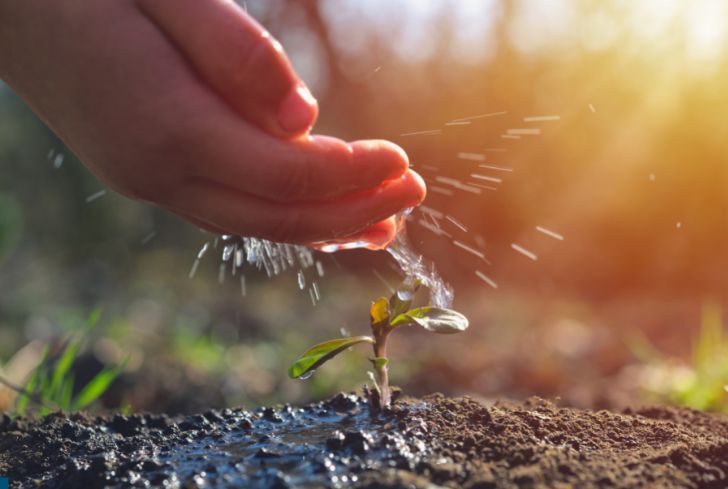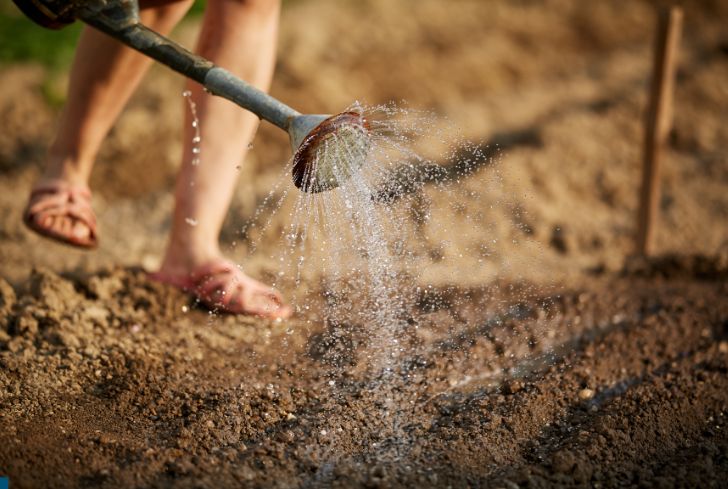Choosing the correct soil for your garden can be challenging, especially if you are growing different plants.
But you should always consider the best soil that boosts plant growth and has excellent drainage properties. Remember that fertile soil, fertilizer, and good drainage will help plants thrive better. Read on to find out if sand is good for drainage and if it improves drainage.
Is Sand Good For Water Drainage?
Yes! Sand is good for water drainage. The coarse grains/particles allow water to filtrate through smoothly. Furthermore, sand has large air pockets allowing faster water penetration. It prevents dampness in the soil and water puddles in the ground.
Sand soil has excellent drainage properties because of its coarse and large texture. Nonetheless, you cannot use sand alone in the garden because it will drain all the water and wash away nutrients in the ground.
Also, a few flood-tolerant plants require fine textured soil which can hold water. Hence, you need to mix sand with other soil to improve drainage.
Note that sand is available in three distinct textures. These include small grain sand, masonry sand, and medium-grain sand.
Small grain sand has the least drainage properties.
Masonry sand has fine particles and the least drainage properties. It is thin and holds water for long, allowing slow drainage.
Lastly, medium grain sand is the best alternative because of its medium-fine particles. It can hold enough water allowing sufficient aeration and absorption. Also, it is the best sand that will prevent roots from rotting.
Is Soil Drainage Important?
All plants require excellent soil drainage. Adequate drainage, on the other hand, is necessary to prevent a plant from suffocating because of the lack of enough air space in the ground. An ideal drainage system should have medium particles that allow water to sieve through and favor healthy plant growth.
Here are the benefits of good soil drainage.
- Drainage is necessary for soil surface runoff.
- Good soil drainage prevents plants from drowning or suffocating
- Allow enough aeration and prevents the roots from overheating
- Stabilizes concentrated nutrient levels in the soil
- Reduces soil runoff
- Reduces soil erosion, especially on sloppy lawns
- Prevent plant roots from rotting or choking
- Adequate drainage is necessary for plant development
Remember that too much water retention in the ground will suffocate plants. But also, quick drainage will dehydrate your plants. So, you should always ensure the soil has proper drainage using these six techniques mentioned below.
- Add the right amount of organic matter to the soil. Organic matter can include leaf mold, shredded bark, and peat moss.
- Build a rain garden
- Build a small pond or a bog garden
- Install an underground drainage system
- Raise the soil bed
- Mix the correct amount of sand with silt
Does Sand Improve Clay Soil Drainage?
Yes. Sand will improve clay soil drainage if the mixing ratio is correct. Remember that clay has the smallest particles, while sand has the largest particles. So, mix the two in the ratio (1:2) for the best drainage. Remember that you risk forming a concrete/cement-like substance if you do not mix it correctly.
Add a 2-inch thick layer of sand to a 4-inch layer of clay, then mix using a rototiller to get a fine texture. Likewise, you can mix sand and clay in a ratio of (1:1) for medium drainage. If you blindly mix the two, it will form poorly drained soil.
Clay has an aggregate structure not easily fixed by adding sand to it. So, you can improve it by mixing the clay with compost. Organic matter softens clay particles and allows more aeration. Though, add a slim compost layer on top of the clay, even without mixing the two. You can use liquid aerators to create airspaces in the clay soil if you do not have compost.
Is Sand Good for Soaking up Water?
Yes! Sand is good for soaking up water. The large air spaces in the sand will increase excess water drainage. Again, remember that sand absorbs plenty of water. Thus, soaking it with water will depend on the surface area of the soil and its permeability.
The large particles in the sand have low surface area but high permeability. Therefore, water will drain efficiently and leave a small amount soaked in the spaces.
On the contrary, sand warms and dries faster than other types of soils. This means it will not retain enough absorption water required by hydrophytes and other aquatic plants.
So, sand granules are great for drainage and not water retention. Similarly, sand is not ideal for plants because more water will percolate in the flower garden leaving insufficient absorption water in the ground.

Is Sand Better Than Dirt For Drainage?
Sand has better drainage than dirt. The loosely-packed large particles and air spaces allow water penetration. However, dirt has medium drainage and is ideal for mesophytes and a few xerophytes.
But before deciding on the type of soil to use in the garden, you should always understand the particular plant you want.
Correctly mix sand and dirt for better drainage, absorption, and retention for medium-condition plants. The sand will help in water drainage, and the dirt will help in water absorption and retention.
Is Sand or Gravel Better For Drainage?
Gravel drains water faster and better than sand. This is because gravel has larger particles than sand. As seen above, efficient drainage works better in soils with large particles. Gravel also has better aeration that reduces waterlogging.
A garden can be predisposed to flooding. So, using gravel will ensure better drainage. Sand retains more water and causes root rot in plants.
When mixing sand and gravel, you should use small amounts of both to make the correct soil drainage ratio. This is an effective technique that guarantees efficient results. Also, mixing gravel and sand in flooded areas will allow precise water retention and drainage. Otherwise, using sand only for your plants can cause plant choking due to insufficient aeration.
What Causes Poor Soil Drainage?
Soil texture is the main reason causing poor soil drainage. Tightly-packed soil particles do not allow water percolation, thus causing suffocation. Excess flooding also causes water logging and affects soil aeration (this is the same as using excess water on your plants).
Usually, a flat or low-lying area does not favor faster drainage than inclined landscapes that allow faster drainage.
Salts in the soil will also cause poor or inadequate drainage. The water from plant roots will flow back into salt-affected soil.
The other factor causing poor soil drainage is the lack of gutters and outlets in the garden, causing excess water retention.
Do Pots Need Drainage Holes?
Yes. It is necessary to have drainage holes in a pot. No matter the type of soil or plant used in the pot. As we have mentioned above, adequate drainage is essential for plant growth. Additionally, good drainage improves aeration in the soil.
Apart from the aquatic plants, other plant species (mesophytes and xerophytes) do not require too much water. Otherwise, they risk choking. Without the drainage holes, the pot risks flooding.
Drilling holes in a pot is necessary to allow efficient drainage, remove excess salts & fertilizer in the soil, allow aeration, and prevent root rot. So, you need to drill holes even if you like controlling the amount of water intake.
How to Add Drainage to Potted Plants?
Increasing the number of holes in a pot is the most effective technique for improving drainage. As discussed in this article, drainage is necessary for plant growth, irrespective of the soil.
But let’s look at the solutions deeper.
Buy pots or use plant pots with adequate drainage holes . Drill the holes using the appropriate tool if your pot has no holes.
Use proper textured soil for efficient water percolation. Add sand or gravel to the potted plants and mix it with the previous soil to prevent water logging.
Adding compost to your potted plants will improve soil texture and boost drainage.
Using the correct pot sizes also improves drainage. Deep pots, for instance, will increase porosity than shallow containers that retain water at the same level.
Lastly, use potting mix instead of soil. You can buy or make pot mix by yourself. Potting mixes have spaces that allow adequate aeration and drainage.
Frequently Asked Questions
1. What are the indicators of well-drained soil?
A well-drained soil has dark brown topsoil, the presence of beetles, earthworms, and ants, and stable soil particles even after a heavy downpour.
2. How do you improve soil drainage?
Use organic matter like farm manure to improve efficient drainage in medium density, compact, and loosely-packed soil structures.
3. What are the effects of poor soil drainage?
Poor soil drainage lowers the integrity of the land and leaves it vulnerable to risk. Poor drainage in the lawn or garden can also cause health and poor crop development. But this usually happens during a heavy downpour.






